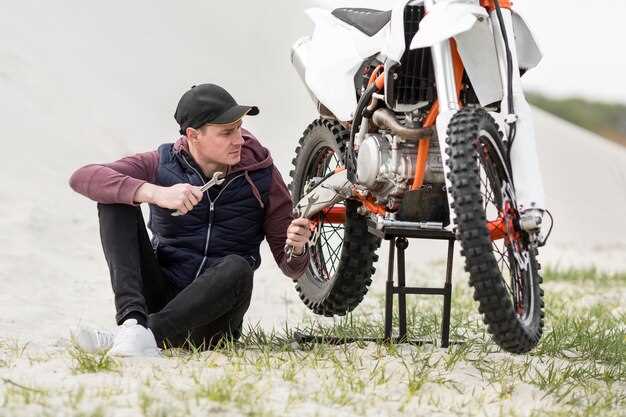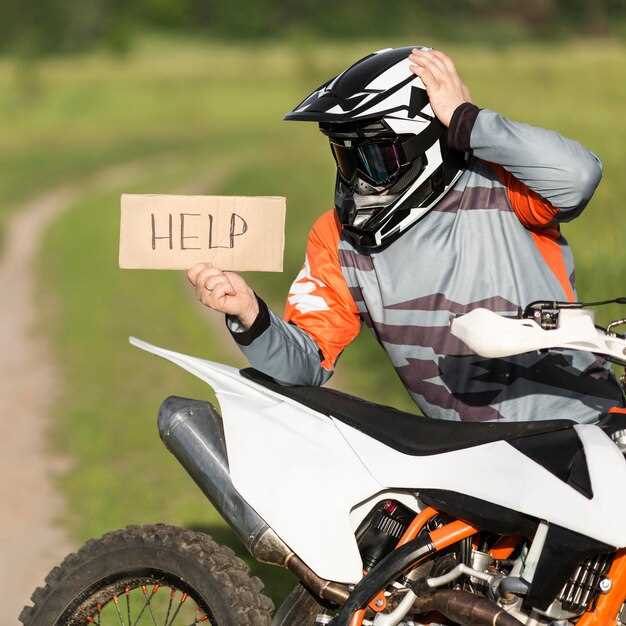
Transporting a dirt bike safely is essential to ensure its condition remains intact while avoiding any potential accidents on the road. Whether you’re heading to a race, trail, or riding spot, understanding the best practices for loading, securing, and hauling your dirt bike will make the experience smoother and more enjoyable. This guide offers key recommendations to help you navigate the transport process with confidence.
Before hitting the road, it is crucial to prepare your dirt bike properly. Start by performing a thorough inspection to confirm that everything is in working order, including the brakes, tires, and fluids. This step is not only important for the bike’s performance but also for ensuring your safety while transporting. Additionally, familiarize yourself with local laws regarding the transport of off-road vehicles, as regulations can vary from place to place.
When it comes to loading your dirt bike, using a steep ramp can help you maneuver it safely onto your truck or trailer. Always ensure that your loading area is firm and level to minimize the risk of slipping. Once the bike is loaded, take time to secure it properly using high-quality tie-down straps. Tightening these straps correctly is crucial–make sure the bike cannot shift or tip during transport. In this article, we will explore the specific techniques and tools that will keep your bike secure and protect it from damage.
Secure Your Dirt Bike Properly in the Vehicle
Securing your dirt bike during transport is crucial to prevent damage and ensure safety on the road. Begin by choosing the right vehicle; a truck or trailer specifically designed for dirt bikes is ideal. Ensure that the vehicle has a flat surface and sufficient space to accommodate your bike without forcing it.
Use high-quality tie-down straps to anchor your dirt bike. Ratchet straps are preferred due to their strength and ability to maintain tension. Attach one end of the strap to the handlebars and the other to the vehicle’s tie-down points. Make sure to secure both the front and rear of the bike to minimize movement during transit.
Additionally, consider using wheel chocks to keep the wheels in place. Placing chocks under the front and rear wheels helps prevent any unintended rolling or shifting. If possible, position the bike upright, as this maximizes its stability during travel.
To further protect your bike, especially if you’re transporting multiple units, use soft padding or blankets around the frame and vulnerable parts to prevent scratches and dings from contact with other bikes or the vehicle itself.
Before hitting the road, double-check that all straps are tight and secure. Conduct a quick inspection of your bike to ensure nothing is loose that may cause damage while transporting. Taking these precautions will help ensure a safe journey for both you and your dirt bike.
Choose the Right Transport Vehicle for Your Dirt Bike
Selecting the appropriate vehicle for transporting your dirt bike is crucial for ensuring its safety and securing a smooth journey. Various options cater to different needs and preferences, each with specific advantages and disadvantages.
| Vehicle Type | Pros | Cons |
|---|---|---|
| Pickup Truck | – Easy loading and unloading – Open bed for larger space – Good visibility |
– Exposure to weather elements – Risk of theft if not secured |
| Trailer | – Increased capacity for multiple bikes – Offers protection from weather – Can be fitted with storage options |
– Requires a suitable towing vehicle – More complex setup and maneuvering |
| VAN | – Enclosed space protects from elements – Enhanced security – Room for additional gear |
– Limited space if multiple bikes are loaded – May require ramps for loading |
| Motorcycle Hauler | – Designed specifically for transporting bikes – Easy to secure bikes with built-in fixtures – Compact and often lightweight |
– May not accommodate larger bikes – Limited storage for extra gear |
Consider the type and size of your dirt bike, as well as the distance you plan to travel, when choosing your transport vehicle. A pickup truck might suffice for shorter trips, while a trailer or van may be better for longer journeys or when transporting multiple bikes. Always prioritize securing the bike properly, using appropriate straps or tie-downs, regardless of the vehicle type.
Additionally, ensure that your chosen vehicle has the necessary towing capacity or space to handle your dirt bike without risking damage during transport. Regular maintenance and inspections of your transport vehicle are also essential for a successful trip.
Prevent Damage with Proper Strapping Techniques
Transporting your dirt bike requires careful attention to how it is secured. Proper strapping techniques can prevent unnecessary damage to your bike during transit. Here are key steps to ensure your dirt bike remains safe and undamaged:
- Choose the Right Straps:
Select high-quality, ratchet or cam buckle tie-downs specifically designed for securing motorcycles. Avoid using regular rope or bungee cords, as they may not hold securely.
- Position the Bike Correctly:
Ensure your dirt bike is placed upright and not leaning to one side. Use a wheel chock if available, to keep the front wheel steady.
- Secure the Front and Rear:
Attach straps to both the front and rear of the bike. This balances the weight distribution and prevents tipping.
When strapping the bike down, follow these specific techniques:
- Strap Placement:
Attach the straps to the frame or other sturdy parts of the bike, avoiding fragile areas such as brake lines or plastics.
- Tightening the Straps:
Gradually tighten the straps while ensuring that the bike remains upright. Do not over-tighten, as this can cause stress and damage to the suspension.
- Check for Movement:
After securing, gently shake the bike to ensure it doesn’t move. Adjust straps if necessary.
Regularly inspect the straps during transit for any signs of wear or loosening. Proper strapping techniques are crucial in ensuring your dirt bike arrives at your destination in pristine condition, ready for the next adventure.
Check Local Laws and Regulations for Transporting Dirt Bikes

Before transporting your dirt bike, it’s essential to familiarize yourself with local laws and regulations that govern the transportation of off-road vehicles. Each state or region may have specific requirements regarding the legal transport of dirt bikes, including whether they can be driven on public roads or specific routes.
Start by checking your state’s Department of Motor Vehicles (DMV) or equivalent agency for any licensing requirements. Some areas may require a special permit for transporting dirt bikes on public roads, while others may have designated routes where such vehicles are allowed.
Additionally, make sure to review any regulations regarding the use of trailers. Certain jurisdictions may have restrictions on trailer size, weight limits, or safety equipment. Ensure your trailer is equipped with adequate lights and reflectors as stipulated by your local regulations.
Be aware of any noise ordinances in your area, as many communities enforce limits on the sound produced by dirt bikes. Using a quieter exhaust system may be necessary to comply with local laws.
Lastly, check if your region has specific insurance requirements for transporting off-road vehicles. Some states may mandate insurance coverage that extends to not just riding but also transportation-related incidents.
Adhering to these laws not only ensures your safety but also helps avoid penalties, making your transport experience smoother and more enjoyable.
Use Protective Gear and Covers During Transport
Transporting your dirt bike carries risks that can lead to damage if not properly managed. Utilizing protective gear and covers is crucial to safeguard your bike against potential hazards during transit. One of the most effective ways to protect your dirt bike is by using customized transport covers designed specifically for your model. These covers provide a barrier against dust, moisture, and minor impacts.
In addition to covers, securing the bike properly with straps and padding is essential. Use soft tie-downs to avoid scratching the frame or bodywork. Make sure to cover vulnerable areas, such as the handlebars and footpegs, with padding to prevent them from coming into contact with other items or the vehicle’s interior during the journey.
Don’t forget about the importance of using wheel chocks or center stands to prevent movement. This adds extra stability and minimizes the risk of the bike tipping over. If possible, transport your bike in an upright position to reduce strain on the suspension and prevent oil from leaking from the engine.
Finally, inspect your protective gear and covers regularly. Look for wear and tear that could compromise their effectiveness during transport. By taking these precautions, you enhance the safety of your dirt bike and ensure it arrives at your destination in optimal condition.
Inspect Your Bike Before and After Transporting
Inspecting your dirt bike both before and after transport is essential to ensure its safety and performance. This thorough examination helps to identify any potential issues that could lead to damage during transit or affect your ride once you reach your destination.
Here are the key steps to follow:
-
Check Fluid Levels:
- Ensure your fuel tank is filled adequately but not overflowing.
- Check that oil levels are sufficient and look for any leaks that may develop during transport.
- Inspect coolant levels to prevent overheating issues after transport.
-
Inspect Tires:
- Examine tire pressure to confirm they are inflated to the recommended levels.
- Look for any signs of wear or damage, such as cracks or punctures.
-
Secure All Components:
- Make sure that all bolts and screws are tightened, particularly those on the handlebars and suspension.
- Check that your chain is properly lubricated and tensioned.
- Ensure that your footpegs and other removable accessories are securely attached.
-
Inspect Controls:
- Test the throttle and brake levers to confirm they are functioning smoothly.
- Check the clutch to ensure it engages and disengages without sticking.
-
Review Safety Features:
- Ensure that all lights and signals are operational.
- Inspect the kill switch and make sure it is functioning as expected.
After transporting your dirt bike, it is equally important to conduct a post-transport inspection. This will help you identify any damages that may have occurred during the journey.
Follow these steps for a thorough post-transport inspection:
- Check for any noticeable scratches or dents on the frame and body.
- Inspect components like the suspension and handlebars for any misalignment.
- Look for signs of oil or fluid leaks that may have developed during transport.
- Test the brakes and throttle once more to ensure they are still working properly.
By consistently following these inspection routines before and after transporting your dirt bike, you ensure its safety and longevity, allowing you to enjoy your rides without worries.
